A Clock for Everyone's
Mantel
by Bob Brooke
The Ansonia Clock Company, based first
in Derby, Connecticut, then in New York, produced thousands of clocks,
but their cast-iron models were some of their best sellers.
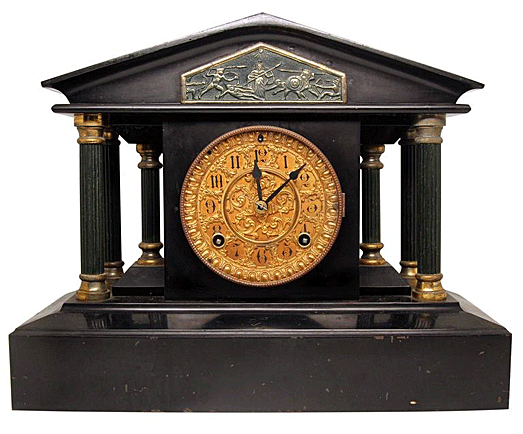
It was one of the major 19th century American clock manufacturers. The
firm produced thousands of clocks between 1850, its year of
incorporation, and 1929, the year the company went into receivership and
sold its remaining assets to the Amtorg Trading Corporation in Soviet
Russia.
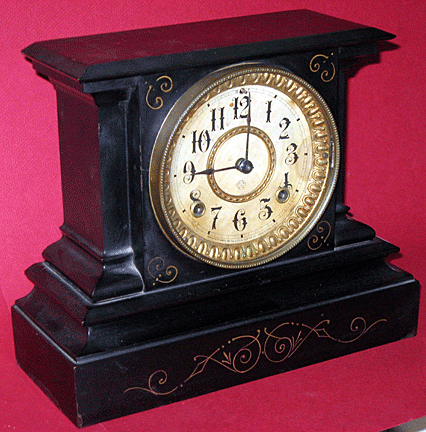 In
1850, Anson Greene Phelps formed the Ansonia Clock Company as a
subsidiary of the Ansonia Brass Company with two noted Bristol,
Connecticut, clockmakers, Theodore Terry and Franklin C. Andrews. Phelps
had been operating a brass rolling mill, the Phelps, Dodge, & Company,
which he formed with two of his son-in-laws. To help build up his brass
business, Phelps decided to get into the clockmaking business as a way
to expand the market for his brass products. It was a shrewd business
move, for it allowed him to profit from the manufacture of a clock’s raw
components and the finished product as well. In
1850, Anson Greene Phelps formed the Ansonia Clock Company as a
subsidiary of the Ansonia Brass Company with two noted Bristol,
Connecticut, clockmakers, Theodore Terry and Franklin C. Andrews. Phelps
had been operating a brass rolling mill, the Phelps, Dodge, & Company,
which he formed with two of his son-in-laws. To help build up his brass
business, Phelps decided to get into the clockmaking business as a way
to expand the market for his brass products. It was a shrewd business
move, for it allowed him to profit from the manufacture of a clock’s raw
components and the finished product as well.
Terry and Andrews thought it was a good business decision for them as
well, giving them ready access to large quantities of brass for use in
clock movements. They agreed to sell Phelps a 50 percent interest in
their clockmaking business in exchange for cheaper brass clock parts and
moved their entire operation to Derby, Connecticut— a portion of which
was later named Ansonia after Anson Phelps—where Phelps had his brass
mill.
By 1853, the firm had begun to produce
cast-iron clocks to meet the needs of middle class families for clocks
that looked elegant but were affordable. That same year, Ansonia
exhibited its cast iron cased clocks, painted and decorated with
mother-of-pearl, at the New York World's Fair in Bryant Park. Only two
other American clock companies exhibited at the fair, which opened on
July 4, 1853—the Jerome Manufacturing Company of New Haven, Connecticut,
and the Litchfield Manufacturing Company of Litchfield, Connecticut,
known for its papier-mache clock cases. Phelps died a rich man a month
after the Fair closed.
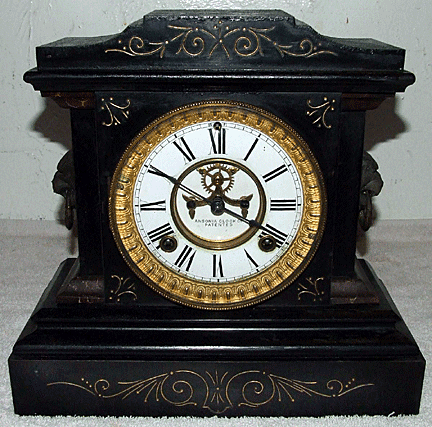 Ansonia
created its cast-iron clocks to imitate elegant ones being made in
France. Its clocks, however, because the company made them of cast-iron,
were less costly to produce, thus less expensive to buy, making them
affordable to middle class homeowners. The paper dial used on this type
of clock gave the impression of more expensive enamel ones very
convincingly. While Ansonia left some bases solid black, others had the
look of faux marble, simulating the French ones. Ormulu figures and
mounts, on those clocks that had them, had a Japanese Bronze finish. The
clocks had an 8-day movement, meaning they only had to be wound every 8
days. Ansonia
created its cast-iron clocks to imitate elegant ones being made in
France. Its clocks, however, because the company made them of cast-iron,
were less costly to produce, thus less expensive to buy, making them
affordable to middle class homeowners. The paper dial used on this type
of clock gave the impression of more expensive enamel ones very
convincingly. While Ansonia left some bases solid black, others had the
look of faux marble, simulating the French ones. Ormulu figures and
mounts, on those clocks that had them, had a Japanese Bronze finish. The
clocks had an 8-day movement, meaning they only had to be wound every 8
days.
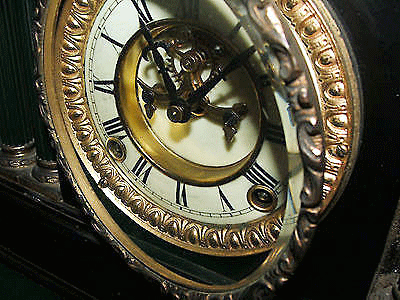 Ansonia
produced a mantel clock with gold gilt accents called the “Boston Extra”
in 1904. This elegant mantle clock features a frame inspired by Greek
architecture with a top cornice that has a gold bow and ribbon motif in
the middle and two reeded columns on each side of the clock face, also
with gold gilt details to the top and bottom. The central clock face is
white with black roman numerals and hands, which was marked with the
maker’s mark near the bottom and was then surrounded by a gilded border
with an egg and dart design. The entire clock sat on a solid rectangular
base. Ansonia
produced a mantel clock with gold gilt accents called the “Boston Extra”
in 1904. This elegant mantle clock features a frame inspired by Greek
architecture with a top cornice that has a gold bow and ribbon motif in
the middle and two reeded columns on each side of the clock face, also
with gold gilt details to the top and bottom. The central clock face is
white with black roman numerals and hands, which was marked with the
maker’s mark near the bottom and was then surrounded by a gilded border
with an egg and dart design. The entire clock sat on a solid rectangular
base.
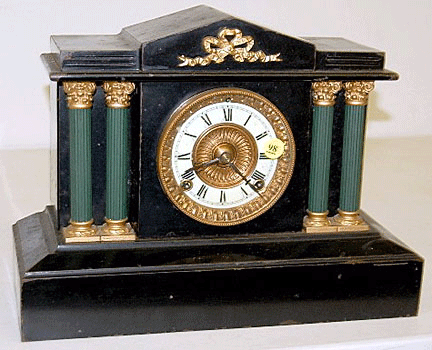
The clock had visible escape movement,
enabling the owner to watch it ticking, and chimes on the hour and the
half hour. It featured a pie-crust bezel, four green, full rounded
pillars on the front and was very heavy, weighing in at 24 pounds. In
1904, the Boston Extra sold for $11.15 to $14.25. Today, one of them in
good condition can sell for over $600.
<
Back to Antique Spotlight Archives Next
Article >
|
